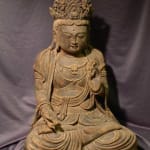Wooden Sculpture of a seated Guanyin, 15th Century CE - 17th Century CE
Wood
31 x 38.5
X.0716
Bodhisattvas are enlightened beings who have put off entering paradise in order to help others attain enlightenment. There are many different Bodhisattvas, but the most famous in China is Avalokitesvara,...
Bodhisattvas are enlightened beings who have put off entering paradise in order to help others attain enlightenment. There are many different Bodhisattvas, but the most famous in China is Avalokitesvara, known in Chinese as Guanyin. Early depictions of Bodhisattva Avalokitesvara displayed male characteristics, but this tradition subsequently became less rigid. By the end of the Yuan Dynasty (AD 1367/8), most Guanyin sculptures depicted the beings as young women, often bearing a vase of holy water to cleanse the souls of those she was bound to protect. According to legend, Guanyin was born on the nineteenth of the second lunar month, achieved enlightenment on the nineteenth of the sixth lunar month and achieved nirvana on the nineteenth of the ninth lunar month. It is said that s/he is the top Bodhisattva beside Shakyamuni Buddha, and an assistant Bodhisattva beside Amitabha Buddha in the Western World of Ultimate Bliss. It is believed that any sentient being who recites his/her name during a disaster would be heard and saved, which can explain why his/her importance to Chinese Buddhism. "Guanyin" literally means "observing the sounds", which refers to the belief that the Guanyin would observe all the sounds in the world, particularly listening for requests from worshippers. The late part of the M’ing Dynasty saw an increased emphasis upon Confucianism, combined with strong martial elements oriented towards defence – the Great Wall dates mainly from this period. When the ultra-conservative Manchus (from Manchuria, north east of China) took over in 1644, they set in motion a series of changes that utterly altered the face of China, including insistence upon the Emperor as a divine being, and a strongly separatist attitude towards the outside world. Paradoxically, the arts flowered during this period, although it has been suggested that the stylistic conventions engendered during this period remained essentially unchanged until the end of the dynastic system with the hapless Pu-Yi (deposed in 1912). This figure, which dates to near the transition of the dynasties (15th to 17th centuries AD) therefore pertains to a highly dynamic and socially restive time, peculiarly at odds with the serene appearance of the figure’s face. The figure is seated in the ‘padmasana’ position with one hand resting on the thigh (‘vitarka mudra’) and the other raised in benediction (‘mudra’). The height of the piece (c. 38”) emphasises the solid solemnity of the body’s position and the tranquil facial expression. The drapery is robustly carved, taking the form of a waist-level belted tunic and a series of other material – primarily scarves – around the shoulders. The hair is gathered into ringlets that protrude from under a highly ornate crown, with anthropomorphic and organic decoration, and hang down the back of the neck in several tails. A double chain and pendant encircles the neck, hanging down to the mid-chest level. The face is superbly carved, with small details faultlessly rendered. This is a very interesting and impressive sculpture, which would provide a wonderful focus for any collection or domestic context.



